
This quiz contains questions pertaining to types of weather, weather instruments, as well as a few questions about weathering and erosion.
- Subject:
- Science
- Material Type:
- Assessment
- Author:
- Heather Rule
- Date Added:
- 07/26/2022

This quiz contains questions pertaining to types of weather, weather instruments, as well as a few questions about weathering and erosion.

You are planning a special trip to a place you have always wanted to visit. You will need to know the weather trends for a specific time of year so that you will know what to pack. Students will create a presentation to organize their packing that should include a line graph included with data collected about local weather and communicate what they should pack and why based on their findings. Students will need to get feedback from peers if their conclusions for they need to pack align with the weather observed. Students will use either a digital format or print format to predict what to pack for a trip of their choosing for two weeks. Students will choose a location, make a prediction, collect weather data, and analyze their results with a graph. Lastly, they will present to classmates to convince them to travel to their location and what to pack.
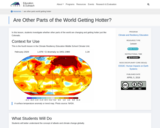
In this lesson, students investigate whether other parts of the world are changing and getting hotter just like Colorado.
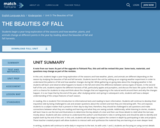
In this unit, students begin a year-long exploration of the seasons and how weather, plants, and animals are different depending on the season by studying the beauties of fall and fall harvests. Students launch the unit by setting up an ongoing weather experiment in order to understand the patterns of fall and how weather changes during fall. While gathering on-going data about the changing weather in fall, students will learn and observe what happens to leaves in the fall and notice the difference between various types of leaves. In the second half of the unit, students explore the different harvests of fall, particularly apples and pumpkins, and discuss the basic life cycles of both. This unit is a chance for students to stop and think about the changes that are happening in the natural world around them and why the changes happen. It is our hope that by the end of the year, after studying winter and spring in subsequent units, students will have a deeper understanding of the unique features of each season.
In reading, this is students' first introduction to informational texts and reading to learn information. Students will continue to develop their inquisitive side by being challenged to ask and answer questions about the content and text they are interacting with. This unit exposes students to a subject matter that is present in their day-to-day lives; therefore, they should be challenged to ask questions and make connections between what they are reading and learning and what they are seeing outside. Additionally, while listening to stories, students will learn how to use the text and illustrations to determine the key details of a text and then use those details to retell what the text was mostly about. Students will also continue to understand the author's and illustrator's roles in writing texts and should be able to identify and explain both by the end of the unit. In this unit, students will also begin to explore the content in-depth by participating in labs and projects. These teacher-created projects will allow students to interact with and synthesize the material they are learning at an even deeper level.
In writing, students will continue to write daily in response to the text. As with units 1 and 2, students are focusing on using correct details from the text to answer the question. Students should be using a combination of words and pictures, depending on the student's development as a writer. Daily teaching points, based on student data, should be included to ensure that students are progressing as writers.
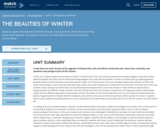
In this unit, students explore the beauties of winter. In the first part of the unit students pretend to be meteorologists as they learn about different weather forecasts and the words that meteorologists use to describe the weather in winter. Students start by exploring generic weather words and then transition into winter-specific words. In the second part of the unit, students explore how animals survive in the winter and the ways in which animals meet their basic needs, even when the ground is covered with ice and snow. In the last part of the unit, students read a variety of Jan Brett texts and use what they have learned about snow and animals to make inferences about what is happening with the different winter animals in the text. By the end of the unit, students should have a strong grasp of what makes winter unique and the different ways plants and animals survive in the winter. Due to the timing of this unit, it is our hope that students will have plenty of opportunities to interact with the vocabulary and content in the natural world around them. When outside for recess or anytime that it snows, students should be pushed to use the vocabulary and content they are learning in the unit so that the content can fully come to life.
In reading, this unit is predominately a collection of informational texts and builds on skills and strategies from earlier units. At this point it is assumed that students are inquisitive consumers of text and are able to ask and answer questions about a text in order to deepen understanding of the content. In this unit, students will continue to be challenged to identify the main topic of a text, retell the key details that connect to the main topic, describe the connection between ideas in a text, and use the illustrations and words to describe and retell what is happening in a text with varying levels of teacher support. Students will also begin to use strategies to ask and answer questions about unknown words in a text, specifically those connected to weather and snow. As part of daily text introductions, students will also continue to explore the purpose behind text features, specifically the front cover, back cover, and title page of a book, and how each feature supports understanding of the text. Many of the skills and strategies in this unit are spiraled from earlier units or will be spiraled through upcoming units; therefore, it is up to the teacher to decide what level of support students need with the particular strategy and scaffold accordingly.
In writing, students will continue to write daily in response to the text. At this point in the year, students should be using a combination of drawing and words to correctly answer the question. Pick focus teaching points based on data from previous units and individual student needs.
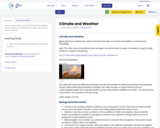
This is a video introduction from National Geographic about weather and climate with a follow-up read and respond activity.

This activity would be a great start to a unit on weather. Ideally, students should create their weather instruments and use them to gather data over a period of at least several days, looking for trends in the weather such as temperature and cloud cover. Show the weather PowerPoint to introduce weather tools and terms. Divide students into teams of 3 or 4 to create one of the tools. The following day, students should use the weather tool they create to take and record measurements using the “Weather Data Sheet." Repeat this process several times over several days (or even weeks).
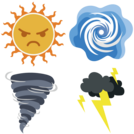
Disease Prevention/Health Promotion is a lesson designed by a Health and Physical Education Teacher to support Health instruction. Created By: Willie Miles Powhatan County Public Schools
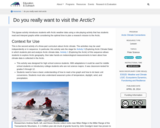
This jigsaw activity introduces students with Arctic weather data using a role-playing activity that has students read and interpret graphs while considering the optimal time to plan a research mission to the Arctic.
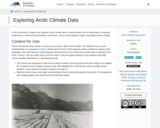
In this activity, students use authentic Arctic climate data to explore albedo and its relationship to seasonal snowmelt as a self-reinforcing feedback mechanism, which is then applied to large scale global climate change.
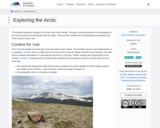
This activity introduces students to the Arctic and Arctic climate. Through a virtual exploration of the geography of the Arctic students become familiar with the region. They are then introduced to meteorological parameters that Arctic research teams use.

Students explore the greenhouse effect in this lesson using a computer simulation and develop a model for how it works.

Students create a weather station to record and analyze data in finding relationships and patterns to predict weather.
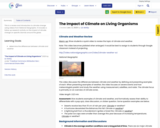
This is a review and introduction to climate change using videos from National Geographic. It includes a follow up research activity on the impact of climate change on specific biomes around the globe.
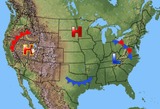
This is a complete 5 E lesson covering weather and weather maps. Materials will be available that can be used for teacher instruction on weather maps. Students will have opportuities to investigate and analyze weather maps and make predictions using maps for impending weather.

This lesson explores if it is normal that world temperatures are rising at the currently observed fast pace.

Video Description: Have you ever wondered where food comes from? Learn how Dr. Catherine Nakalembe uses NASA satellite data to show the health and location of crops around Our World. Maps created from these data help people become more food secure. You can help, too. Using the GLOBE Observer App, you can help scientists validate satellite data by describing land covering through the Adopt a Pixel program. Video Length: 5:23. NASA eClipsTM is a suite of online student-centered, standards-based resources that support instruction by increasing STEM literacy in formal and nonformal settings. These free digital and downloadable resources inform and engage students through NASA-inspired, real-world connections.NASA eClips Our World videos (grades 3-5) help students understand the differences between science (the natural world) and engineering (the designed world). These video segments supplement elementary learning objectives not only in science, technology, engineering and mathematics, but also in reading, writing, visual and performing arts.

Video Description: Satellites are expensive to build and expensive to get into space. With all the changes in technology, is there a way to make satellites smaller? Find out just what NASA can pack into a 1U CubeSat, a satellite small enough to fit in your hand. Video Description: 3:24.NASA eClipsTM is a suite of online student-centered, standards-based resources that support instruction by increasing STEM literacy in formal and nonformal settings. These free digital and downloadable resources inform and engage students through NASA-inspired, real-world connections.NASA eClips Real World segments (grades 6-8) connect classroom mathematics to 21st Century careers and innovations. They are designed for students to develop an appreciation for mathematics through real-world problem solving.

Video Description: CubeSats are changing the way we collect information. They may be small, but these little satellites are helping us answer big questions. And using a swarm of CubeSats can give us simultaneous measurements without repeatedly sending commands to the satellite to tell it what to do.Video Length: 2:21.NASA eClipsTM is a suite of online student-centered, standards-based resources that support instruction by increasing STEM literacy in formal and nonformal settings. These free digital and downloadable resources inform and engage students through NASA-inspired, real-world connections.NASA eClips Real World segments (grades 6-8) connect classroom mathematics to 21st Century careers and innovations. They are designed for students to develop an appreciation for mathematics through real-world problem solving.

Video Description: Our Earth is a dynamic system with diverse subsystems that interact in complex ways.What are those subsystems and how do they interact?How are these subsystems and the global Earth system changing?What causes these changes?How does NASA monitor these changes?How can Earth system science provide societal benefit?Jessica Taylor, an atmospheric scientist at NASA Langley Research Center, and Dr. Steven Pawson, an Earth scientist from NASA Goddard Space Flight Center, help answer these questions and demonstrate how mathematical modeling helps scientists in their predictions of climate, weather, and natural hazards. Video Length: 5:02.NASA eClips Real World segments (grades 6-8) connect classroom mathematics to 21st Century careers and innovations. They are designed for students to develop an appreciation for mathematics through real-world problem solving.